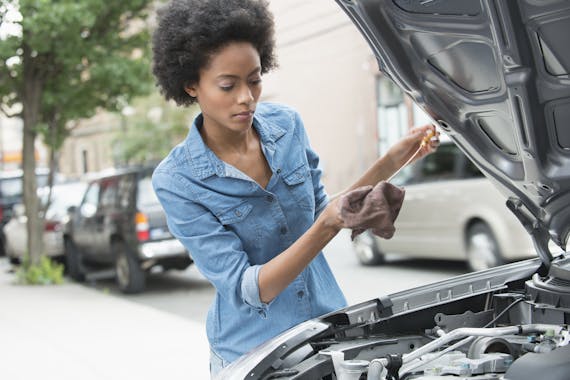Regular car maintencance checklist

Regularly checking your car will not only help it run better, but it will also prevent (sometimes expensive) problems when you least expect them. These checks will go a long way to saving you money – and stress.
Tyres
Tyres are one of your car’s most important components. Check them regularly – especially if you’re taking a long trip – and you minimise the chance of any potentially dangerous incidents.
Firstly, you need to know what the correct tyre pressures for your car is. You’ll find them in the car’s handbook, on a sticker found in the frame of one of the car’s front doors, or on the fuel filler flap. To be on the safe side, check them every couple of weeks with a gauge that you can pick up from a car accessories shop (or online) or using an airline at a filling station.
You’ll also need to check the tread and condition of your tyres, looking for any cuts on the sidewalls or bulges that hint at issues that could cause a blowout.
If you have a spare tyre (many new cars just have tyre repair kits), remember to check that too. It needs to be the right pressure and in good condition, so that it’s road-ready in an emergency.
On a related note, you should know where the wheel-changing toolkit is located. This is usually a jack and tools for removing the wheel, including the key for the locking wheel nut. And make sure you know where the jacking points to lift the car are: you don’t want to be scrambling around trying to find them when you are in the stressful position of having to fix a puncture.
Engine oil
Ensuring your engine oil level is topped up will help avoid most major engine problems, so check it every couple of weeks as well as before any major trip.
To do this, identify where the dipstick is in the engine bay (the information is in the car’s handbook), take it out and wipe it with a clean cloth. You’ll see two marks – one for the minimum and maximum oil levels. Replace the dipstick and take it out again. You’ll see the current oil level, which should be between the two marks.
If the oil level is low (below the minimum mark, or only a little above it), top it up with the specific product that is recommended for your car by the manufacturer. If you find that you have to top up the oil regularly, you have a problem, so you need to get it checked out.
You’ll also need to replace the oil and the filter whenever you have the car serviced, so it’s important to stick to your car’s service schedule.
Coolant level
Regularly checking the coolant level and topping it up is another important maintenance task. This should only be performed when the engine is cold.
You’ll need to start thinking about adding antifreeze in autumn. Antifreeze prevents the build-up of corrosion within the cooling system and stops the water in the coolant system from freezing. The concentration should be at approved levels. In the winter, you should have a 50/50 mix of water to antifreeze to protect your engine at temperatures below freezing.
It’s also worth remembering that if you’ve been topping the water levels up over the summer, the percentage of antifreeze will be lower than 50%. If you want to check the exact proportions, you can pick up an antifreeze tester for just a few pounds at a car accessories shop.
Windscreen
Check your windscreen regularly for any chips or stone damage: not only can they impair the vision of the driver and prove a distraction, if left unchecked they can spread or cause secondary cracks.
The windscreen wiper blades also need regular attention as they can wear down over time to the point where they start smearing the windscreen. Look to replace them at least once a year. If you’re taking a long trip and they look worn, you should also change them as they’ll have a lot to cope with, from bugs in the summer to rain in winter.
Top up the screenwash level regularly using a good additive, as water alone won’t clear the oily grime thrown up from the road (plus it’s more likely to freeze in winter).
Lights
All your car’s lights – including indicators, brake and fog lights – need to be checked on a weekly basis.
If any of them seem to be fading or failing replace the bulbs straight away. You can do it yourself, but it might be worth getting it done professionally - with something as important as lights, you don’t want to take any risks.
Make sure you clean them regularly, too, wiping them over with a damp cloth after driving in bad weather.
Make searching and staying updated even easier.